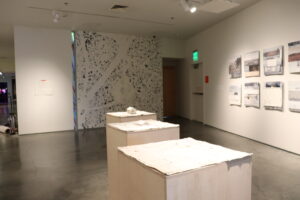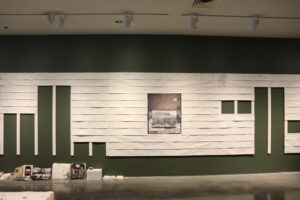Nick Larsen is a Nevada-born contemporary artist (and University of Nevada, Reno alum) who “works in the no-man’s land between fictional archaeological inventory and autobiography” (per Southwest Contemporary). Coincidentally, his most recent exhibit, Old Haunts, Lower Reaches is housed at the Nevada Museum of Art.
I met Larsen on the third floor of the museum, where his curator Colin Perry put the finishing touches on the space. The exhibit was almost ready with just a few signs needing placement. Tall and soft-spoken, Larsen and I spoke in a children’s craft room a few doors away from the exhibit.
The exhibit focuses on Stonewall Park, a community imagined by the couple Fred Schoonmaker and Alfred Parkinson in 1983. Schoonmaker and Parkinson had pictured Stonewall, a gay community in rural Nevada, as they felt it was the only way to truly live safely. Schoonmaker believed Stonewall Park would have to be built outside both Washoe County and Clark County. He didn’t think either county was forward-thinking enough to support his idea.
Unfortunately, Schoonmaker was right. He and Parkinson looked at three locations– Silver Springs, Rhyolite, and Thunder Mountain– and they were essentially chased out of those locations. Between rural community pushback and a lack of funding, Schoonmaker and Parkinson were forced to give up and return to Reno.
“What you see in the material that records this time period is a real fear about this planned community becoming a hot zone for HIV,” Larsen says, referencing the newspaper articles from that time (which are all housed at the University of Nevada, Las Vegas libraries). “You can call it backlash, but really it was people who were afraid of what a community like this means for that area.”
In 1983, (at the time of planning for Stonewall Park), 16,500 deaths from HIV/AIDS were confirmed. These numbers classified HIV as an epidemic at the time. Ronald Reagan, who was president during the AIDS crisis, would not address the epidemic publicly until 1985 in a press conference. This was four years after the first U.S. confirmed case in Los Angeles, and two years before Fred Schoonmaker would succumb to the illness.
Most of the exhibit is focused on Rhyolite, a town around 2 hours north of Las Vegas (near Beatty, for anyone who makes the Reno-Vegas drive annually). Larsen began photographing the area about a year before he began the project. One small standalone house structure from the 1980s was photographed multiple times by Larsen, and it collapsed at some point during the year before the exhibition came to fruition due to elemental changes and old age. Although this house was extremely old and run down, Larsen saw beyond that and more of what could have been (had Schoonmaker not faced intense scrutiny and hatred).

The Rhyolite house– past, present, and future.
Larsen got his degree from UNR in studio art but worked in the archaeology field when in Reno. Here, he developed the idea of ‘making do’ by seeing how older societies repurposed materials to have new uses. In the exhibit, this comes in the form of a collage that spans the length of one wall.
“Bits of material–human-made, cultural material– found within the landscape can tell a story of who was there, what they were doing, and how long they were there,” Larsen says. “The collages play with that idea.”
This directly influences the exhibit, as the denim Larsen used are bits and pieces from other projects he had completed. These remaining pieces challenged Larsen to see if he could ‘make do,’ and are used in both the house models and the collage. The denim used was sourced from Ohio and then bleached by Larsen to give it a newer look. This ties into the meaning of the exhibit, as it focuses on what Stonewall Park could have been. By using repurposed bleached denim, Larsen builds a past, present, and future for museum visitors.
One wall of the exhibit uses a whole lot more than bleached denim. On the collage wall, Larsen used printed Tyvek (material used to print architectural blueprints), buttons, repurposed billboards, and autobiographical pieces (from some of his previous work). From a distance, these pieces are somewhat camouflaged; as viewers get closer, more material and sketches become visible. The levels of the collage represent Rhyolite– from past to present.
“They’ve sort of taken the form of this landscape and house structure,” Larsen says. “They also hold sort of the residue of their past life because they are clearly not new denim. They have a history to them and a wear to them.”

Larsen’s multimedia collage spans the length of this wall.
While Larsen had always driven through Rhyolite, he didn’t start taking pictures of it until about 2 years before the exhibition opened. Then, he met Perry, curator at the Nevada Museum of Art, and they began planning about a year and a half ago.
While he doesn’t live in Reno now, Larsen gives credit to the art scene of UNR and Reno’s downtown area as his main inspirations in undergrad. Going somewhere where creativity was prioritized allowed him to flourish.
“[UNR] kinda became the foundation for me for what being an artist looks like,” Larsen says. “Between UNR and The Holland Project, I had an opportunity to curate exhibitions early on.”
Larsen specializes in giving old material a new life; anyone visiting Old Haunts, Lower Reaches, can see that. Larsen curates a unique exhibit that shows a small, somewhat unknown corner of Nevada’s history in an educational way. Although you can’t visit Stonewall Park, you can visit the third floor of the Nevada Museum of Art.
Larsen’s exhibit is on display at the Nevada Museum of Art from now to July 7, 2024. The Nevada Museum of Art is free for UNR students.
Larsen’s previous work can be found on his website.
